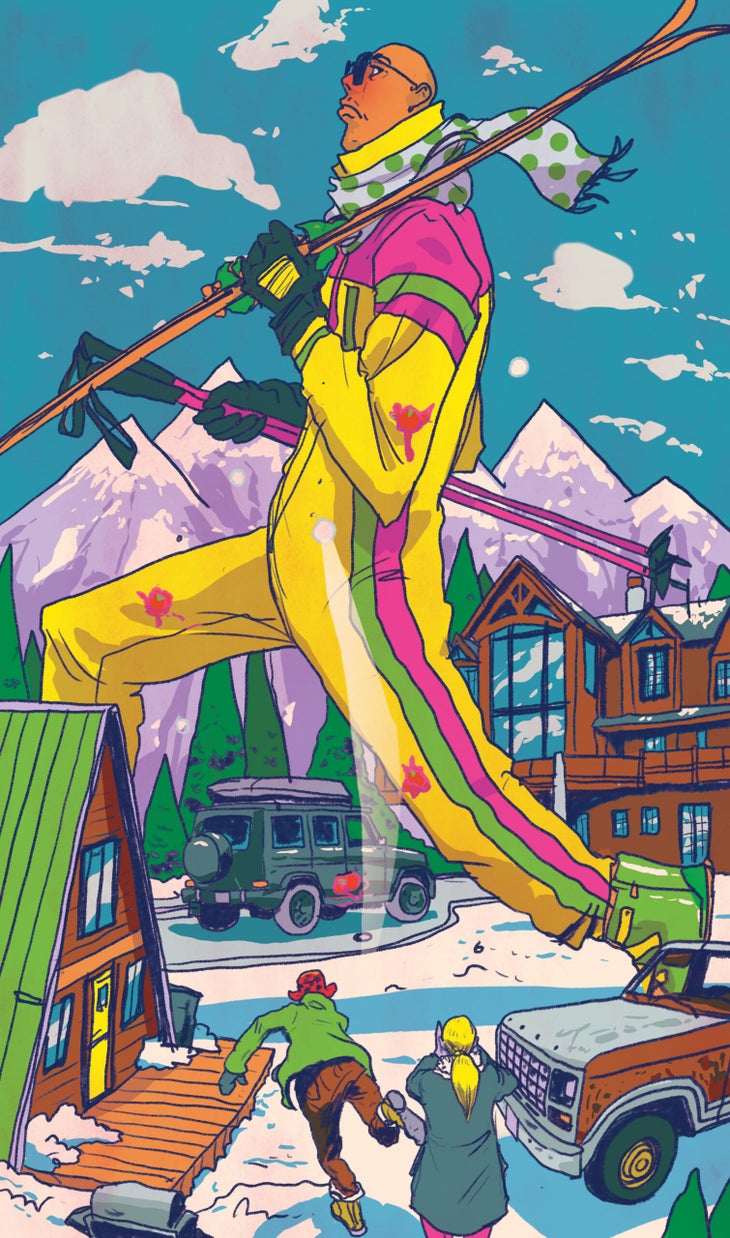Products You May Like
Living in a mountain town as a seasonal worker is to accept a life of unrequited love. The sparkle of morning light on freshly fallen snow will enchant even the most stonyhearted local, but after you shovel out and head toward the hill, it’s impossible not to notice moving trucks are everywhere and eviction notices pile up quicker than the snow.
After spending a few years bouncing between ski resorts, my girlfriend and I moved to Mammoth last winter to chase the dream of embedding in a real ski town. We came with the idea of planting roots—becoming locals. But that fantasy dissolved quickly. Almost from the moment I arrived, I felt pushed out. The few locals who brought us into their circle in the midst of a global pandemic felt the squeeze, too.
We were fortunate to find housing at first, but when our lease ended after six months, our landlord increased the rent by $1,500 a month. Skyrocketing housing prices mean landlords don’t want to charge locals reasonable monthly rents when they could easily get higher weekly or nightly rates by renting on Airbnb and VRBO. Meanwhile, plenty watched their homes double in value in under a year and simply cashed out.
It’s hard to blame them, but easy to be disappointed when the rental market shrivels to a trickle. Mammoth Lakes Housing, a non-profit that seeks to unite seasonal workers with one of the 140 low- and moderate-income rental apartments in the area, estimates the community is more than 260 homes short of the number it will take to keep the town’s businesses running.
At night, I walked my neighborhood streets in near-total darkness; not a single home was lit from the inside. As people were forced from their homes by exorbitant rent costs, the vast majority of the housing supply sat empty.

My friends grew bitter, and so did I. This bitterness fueled a certain kind of localism, an idea that I deserved to be here more than the tourists. I rearranged my life to ski here every day, so I must love it more. In what increasingly felt like a fight to stay in my new home, I discovered that this localism is the tip of an arrow laced with poison.
Here’s the thing: we want localism to mean a sense of community and belonging on the mountain. We want that sense to make up for the metaphorical shit we have to eat. Localism makes us feel included.
But that’s not what localism is, really. Localism is exclusionary, a form of dirtbag-inflected NIMBYism brandished like a broadsword to excuse bad behavior and worse attitudes. And while my fellow locals might clutch their pearls to hear it, localism can be as bad for skiing as $200 lift tickets, ski resort monopolies, and paid parking.
Don’t believe me? Last season, I witnessed a group of locals bully a woman to tears on her first day of the season. It was January, Mammoth got a winter’s-worth of snow all at once, and a powder panic like I’d never seen took hold of the town. Ten feet of snow buried the resort. The mountain could only open two lifts, but locals, Los Angeles storm chasers, and fly-in tourists alike descended upon them.
As we shuffled together through an obnoxiously long lift line, this woman couldn’t scan through the gate because she had left her phone in the same pocket as her ski pass. A group of college-aged kids sipping Fireball began to throw snowballs at her. As an overwhelmed liftie pulled her aside to solve the problem, other locals began hurling insults at her. I caught “fucking idiot tourist” and a few other lines unfit for print. This was just one instance in which locals turned a bad situation worse over violations of ski town rules that most tourists and never-evers would have no reason to learn in the first place.
I get it. The pressures of working for low wages in a ski town batter my friends; burdensome rent and serving people who see you as a replaceable blip on their high-dollar vacation can turn good people cruel. When you finally get the chance to ski, the thing that brought you here in the first place, it’s all you can think of.
But loving something enough to suffer for it doesn’t give anyone the right to keep it from someone else. There is so much exclusion built into skiing that feels out of our control, but our attitudes as locals are not. We shouldn’t be the thing that stops new skiers from entering the sport. Skier participation numbers have been flat for decades, and obnoxious localism could be the straw that breaks the camel’s back for a new skier who already feels out of their depth.
If we want to create a better, more inclusive skiing community, then we owe it to both locals and tourists to be self aware and show some damn kindness to others. We do want that, whether we know it or not, because a more inclusive skiing community (and more skiers) means a healthier Mammoth. And Jackson. And Stowe.
More skiers in town means a more robust ski town economy, a larger voting bloc that cares about climate change solutions, and more tips in your pocket at the end of your Friday night shift. If you’re a local, whatever that means to you, find patience for people who may one day love the sport and the mountain just as much as you do. It was once your first day in a new place, too.
Oh, and if you’re reading this from your Malibu beach house as your second home gathers dust in Mammoth, consider renting one of those eight bedrooms to a future local who’s happy to be your waiter the next time you’re here. I’m still looking for a place.
